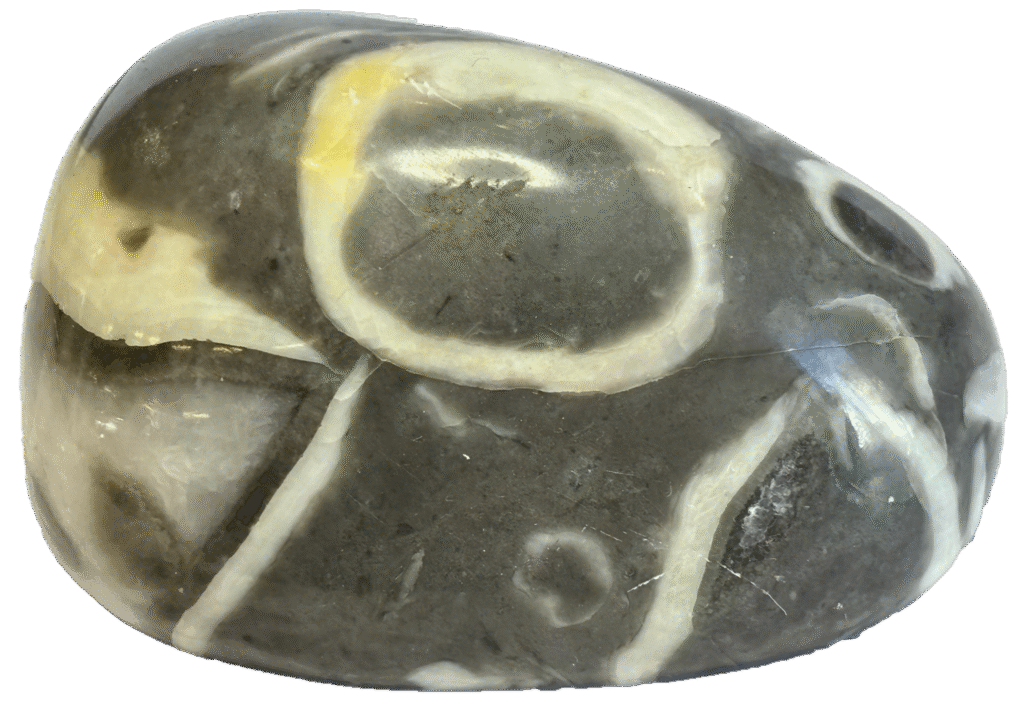
Marble derives its name from the Greek word “marmaros,” meaning shining stone, reflecting its smooth, polished appearance. Some traditions refer to it as White Stone or Sacred Stone, due to its historical use in temples, sculptures, and monuments. In metaphysical circles, Marble is known as the Stone of Purity and Strength, valued for its ability to enhance focus, protection, and personal transformation.
Composition, Physical Characteristics, and Varieties
Marble is a metamorphic rock, formed when limestone undergoes heat and pressure, resulting in a dense crystalline structure. It typically contains calcite, giving it a lustrous, veined appearance. Marble ranks 3 to 5 on the Mohs hardness scale, making it softer than quartz but highly durable.
Varieties of Marble include:
- White Marble – classic pure white, used in sculptures and temples.
- Carrara Marble – soft grey veining, highly prized in architecture.
- Black Marble – deep charcoal tones, often featuring gold or white veining.
Geographical Locations Where It Is Found
Marble is sourced from Italy, Greece, India, and the United States, with Carrara, Italy producing some of the finest specimens. Other deposits exist in Spain, China, and Turkey, contributing to global trade in decorative and sculptural marble.
Archaeological and Significant Finds with Historical and Current Usage
Marble has been treasured for thousands of years, particularly in Greek, Roman, and Egyptian architecture. The Parthenon, Taj Mahal, and Michelangelo’s sculptures all feature exquisite marble craftsmanship.
Today, Marble remains popular in art, construction, and spiritual practices, valued for its timeless elegance and grounding energy.
Interesting Facts
- Marble absorbs negative energy, making it ideal for meditation spaces.
- Renaissance artists preferred Carrara Marble for its refined texture.
- Some believe Marble enhances clarity and determination, supporting focus in daily life.
Folklore, Superstition, Legends, and Tales
Marble has long been associated with purity and resilience, believed to amplify inner strength and wisdom. In ancient Rome, it was used to honour deities, symbolising divine protection and endurance. Some cultures believe it encourages discipline, helping individuals stay committed to their goals.
Mystical Healing Properties, Astrology, and Zodiac Associations
Marble is valued for its clarity, strength, and grounding qualities, helping individuals maintain focus and resilience. Astrologically, it resonates with Capricorn, Virgo, and Libra, complementing their practical and disciplined nature:
- Capricorn – strengthens determination and perseverance.
- Virgo – enhances clarity and organisational skills.
- Libra – promotes balance and emotional stability.
Chakra System Connections
Marble primarily connects with the Root and Crown Chakras, fostering stability, focus, and spiritual insight.
Use as a Birthstone and for a Wedding Anniversary
Though not a traditional birthstone, Marble serves as an alternative crystal for Capricorn and Virgo, supporting their strong-willed and focused qualities. It is also gifted for a 60th wedding anniversary, symbolising endurance and lasting commitment.
Crystals That Work Well with Marble and Those to Avoid
- Best Pairings:
- Hematite – enhances grounding and strength.
- Clear Quartz – amplifies clarity and focus.
- Obsidian – deepens protection and resilience.
- Crystals to Avoid:
- Carnelian – its fiery energy may contrast with Marble’s stabilising presence.
- Blue Kyanite – its high vibrational frequency might disrupt Marble’s grounding effects.
Marble remains a powerful stone for purity, endurance, and spiritual insight, offering strength in transformation. Whether used in architecture, energy work, or personal development, it fosters balance, wisdom, and resilience. Let me know if you’d like any refinements!

Marble
Marble enhances clarity and serenity. A symbol of timeless beauty and strength, it supports inner peace, focus, and grounding with elegant energy.
